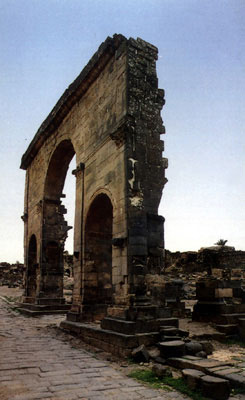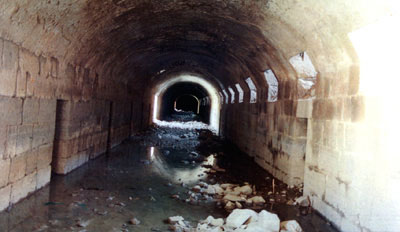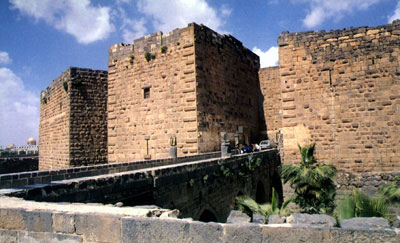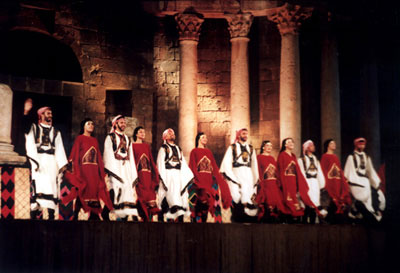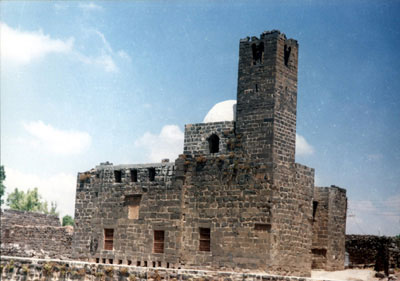It is the center of the town, it is /100/ km from Damascus. The origin of the word is Kanaani it is mentioned by Thutmose (1490-1436) B.C. It is written in Hieroglyphic tablets as ((Atharaa)). It was mentioned also in the Old Testament as ((Idraai)) while the Arab geographers called it ((Athraat)). Many vestiges can be found in town such as the cave and ancient dwellings. The roman amphitheater, the remnants of some roman baths, an old rail ways "Hijaz railway". The old Omari mosque that has a special importance in mosques architecture during the Omayad and Ayoubi periods.
Daraa occupies “Strategical, Tourist, Historical” consequence.
It occupies an area of about (3730) square km. Its population reaches up to thousand inhabitants.
Bosra
Situated in the vast Hawran plain, some 145 kilometres south of Damascus. It is an extremely ancient city mentioned in the lists of Tutmose III and Akhenaten in the fourteenth century B.C. The first Nabatean city in the second century B.C., it bore the name Buhora, but during the Hellenistic period, it was known by the name of Bustra. Later the Romans took an active interest in the city, and at the time of the Emperor Trajan it was made the capital of the Province of Arabia (in 106 B.C.) and was called Neatrajana Bustra. The city saw its greatest period of prosperity and expansion then, became a crossroads on the caravan routes and the official seat and residence of the Imperial Legate. After the decline of the Roman Empire, Bosra played a significant role in the history of early Christianity. It was also linked to the rise of Islam, when a Nestorian monk called Bahira, who lived in the city, met the yound Muhammad when his caravan stopped at Bosra, and predicted his prophetic vocation and the faith he was going to initiate.
The oldest Islamic square minarets (still standing) are found in Bosra, whose prosperous role as an important halt for pilgrims on the way to mecca lasted until the 17th century.
The most interesting part of the city today is the famous Roman theatre built in the second century A.D., which seats 15 thousand spectators, and is considered one of the most beautiful and well-preserved of Roman amphitheatres in the world. The stage is 45 metres long and 8 metres deep. Every summer, it hosts Arab and international performers who entertain audiences during the Bosra Art Festival against a majestic background of Roman columns and arches.
The city itself contains a great number of Roman ruins, a part of the Byzantine Bahira Church, as well as the al-Mabrak Mosque, which is said to have been erected on the site where the Prophet's camel stopped to rest. There is also the Omar Mosque (also called the al-Arouss Mosque), which is the only one of its type remaining from the early days of Islam, and it retains its 7th century primitive form.
An important Muslim citadel, dating back to the Ayoubite and Mamluk period still stands, and one of its towers now houses a museum of Antiquities and Traditional Arts.
The Citadel of Bosra
When past and present embrace. The citadel stands as a witness to relate stories about many civilization that Bosra hugs through its historic periods, culture put most of its art and creation in stones to create a marvelous art narrates the story of these culture, however Bosra counts one of the most important citadel that existing in the world.
It is composed of three towers, the southern, the eastern and the western which border on the outer walls of the theater, moreover, these towers linked to all entrances and exits of the theater, as the citadels contains one of the most important theater that existing in the world. The citadel is surrounded with a trench that full of water used for military purposes. At last, the entry to citadel is done by a moving wooden bridge leans on five arches to move it at need.
The Theatre of Bosra
This building gathers splendor construction and accuracy of beautiful art, and it is the lonely perfect theater which still has most of its parts and elements since the roman age.
The amphitheater is sculptured of basaltic stone and appears with all its parts. Also, the acting stage and all its branches are not protector and decorated by mihrabs, big doors, and roofed portico on the common style of the roman play. Grounds crowns the building, moreover it is believed that the theater rises on citadel of the Nabatean age - the amphitheater is built as the same style of Helanstic theaters where its sides spread out more than half at a circle and it walls raise more than twenty meters. The amphitheater is surrounded with eartly doors and upper windows, some are open and others are closed. The latest widens more than 15000 spectators, three parts separate by passages where the doors that spectators enter and exit are open, its length 45m, the breadth (8.5) m.
THE MOST IMPORTANT VESTIGIAL SITES
The roman amphitheater: it is inside the citadel. Its length is (45)m. and its breadth is (8.5)m.
The roman theater: it is considered the most beautiful theater all over the world.
The western gate (bab al hawa)
The old roman bathes
The palace of the emperor Trajan.
The nabateans gate
The cathedral
The king's daughter bed
Fatema mosque
The houri's water temple
The monk (Bahira) der.
The Oumari mosque
The Islamic bath
The under ground bazaar.
The Western Gate Bab Al Hawa:
The first thing which is seen in the city from the west is (Bab al Hawa) .It was established in the second century A.D. It connects antique remnants the fence at two sides and consists of high arc covered with basaltic layer. There are mihrabs (niches) at the two frontages. The width of the entrance is 5 m and the frontage about 11 m.
The Terrestrial Market:
It was built in the second century A.D., this market located at the north side from the straight street connected between the western city's gate and the Nabatanyan's gate at it's intersection with the coming street from al-jahir spring. And this earthly market was decorated by four piles for columns .It was believed: This building comprised of two floors : The upper one has a passage overlooks at the public yard from the north and at the portico from the south, but what still up till now is the down stairs, the latest was used as a store for goods at night. It's length is (106)m, width (5)m, and it’s height (4)m. It was lighted by (34) windows from the southern side. In addition too, there are six of doors control the public square from the north.
The Central Arc (Bab Al Kendel):
It was built in the third century A.D. To eternize the leader's triumph of "Partia Group” namely Julianus, during the period of Arabian emperor "Philip". Julianus presented sacrifices for gods at his coming back from the battle, as it was common during the roman era. The central arc composed of two frontages; the south face dilapidates by the force of seisms. The northern frontage is formed from three arcs: the highest one is the middle, it's height reaches 13m.
The Temple Of the Water Nymphs:
The remaining parts of the temple are: (four columns by Corinthian crowns). Its height reaches 14m, diameter is 1.20 m. It is used as a watering place at the intersection of the main street with the extended street from the bathrooms to the Omari mosque, and the parts of the temple were dilapidated by the force of seisms.
The Main Market: (The Caravansary Of The Molasses) (Khan Ad-debs):
It was specified for showing industries and agricultural crops which are known in the region .The building had a ceiling and a big yard. Its length reached 70 m, width 20 m, the ceiling was consisting of a burned volcanic stones, lime and sand, the yard was decorated by big and small niches and prominent stones specialized to set statues. it was guarding . the merchants against rain in the winter, heat and dust in the summer.
Alhaj- Pool:
It was built in the Ayopian age as watering place for pilgrims who passed by Bosra during their leaving to Macca and their return, also to supply the citadel trench, and its wells of water, its length (155)m, the breadth (122)m, the depth (8)m from the east, (12)m from the western side. ln the middle a square support to rest the swimmers. Historians said: it belongs to the Roman era.
Abu- Alfidaa School:
In habitants named it "the mosque of tannage" actually it is a school erecting in (Sultan abu al Fidaa esmaeel) era during his life, then a cemetery after his death as the writing on the south face which over looks at (pool alhajj) refers to and the tablets pointed out that it was built in 1225 A.D. The school is composed of ahall, and six rooms included the cemetery, the ceiling of the hall is consisted of stony, rectangular door steps that lean on six high arch, but the ceiling of the cemetery room is a dome of brick.
Menjak’s Bath Room:
It was erected in the Atabekey era in the end of the twelfth century (12th) A.D.,at eastern side that facing the Omari mosque by the deputy of Syria and Damascus. lt is a wonderful type of architectural engineering in the middle age where it rises on a piece of land, its era 14x45, the latest consists of three suites: the reception one, the bathroom its self and the service rooms. In addition to a wide hall and three rectangular cabinets.
The palace of saints head:
It’s located near the eastern side from the cathedral church. It counts the most important and beautiful architectural ruins in Syria, and it is between the building of Nabatean temple and pool pilgrim. The palace is a seat for the Arabic ruler.
